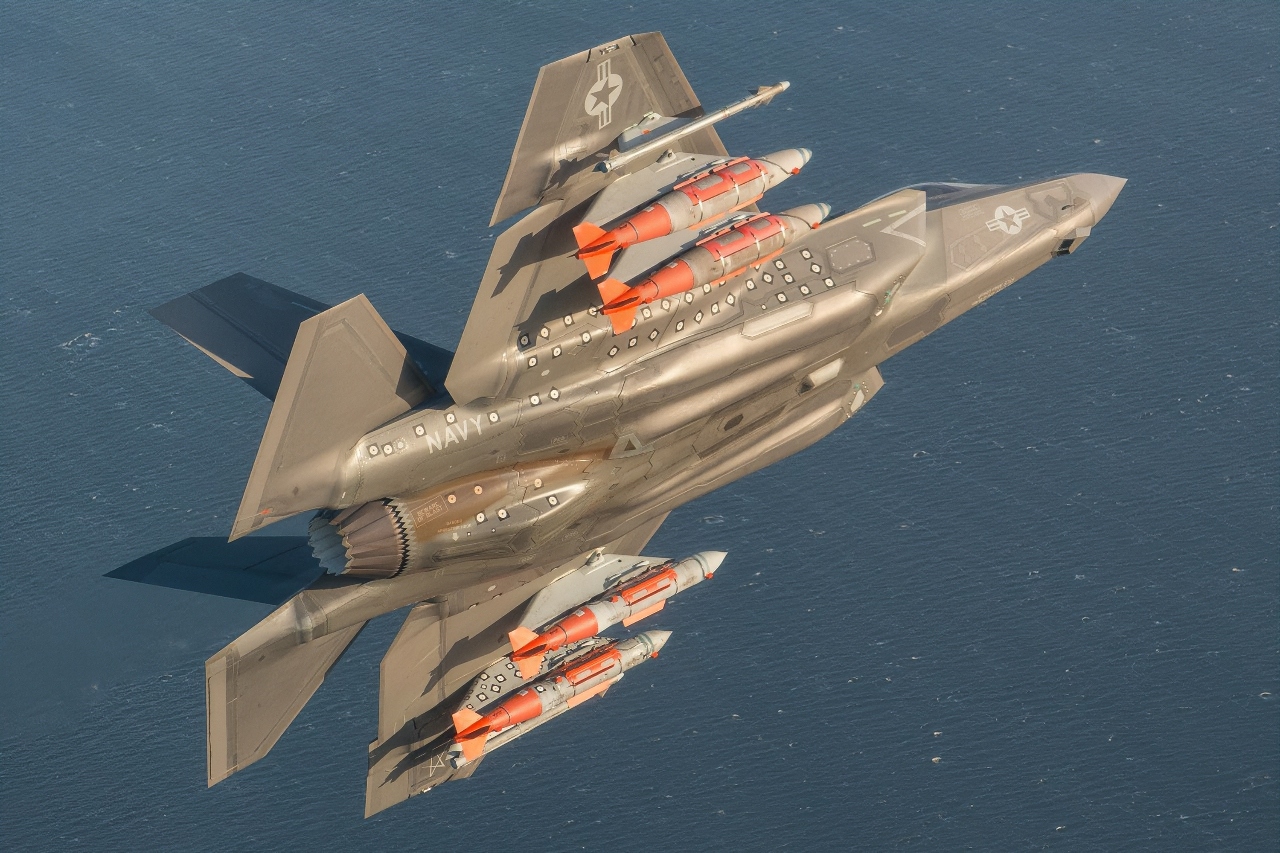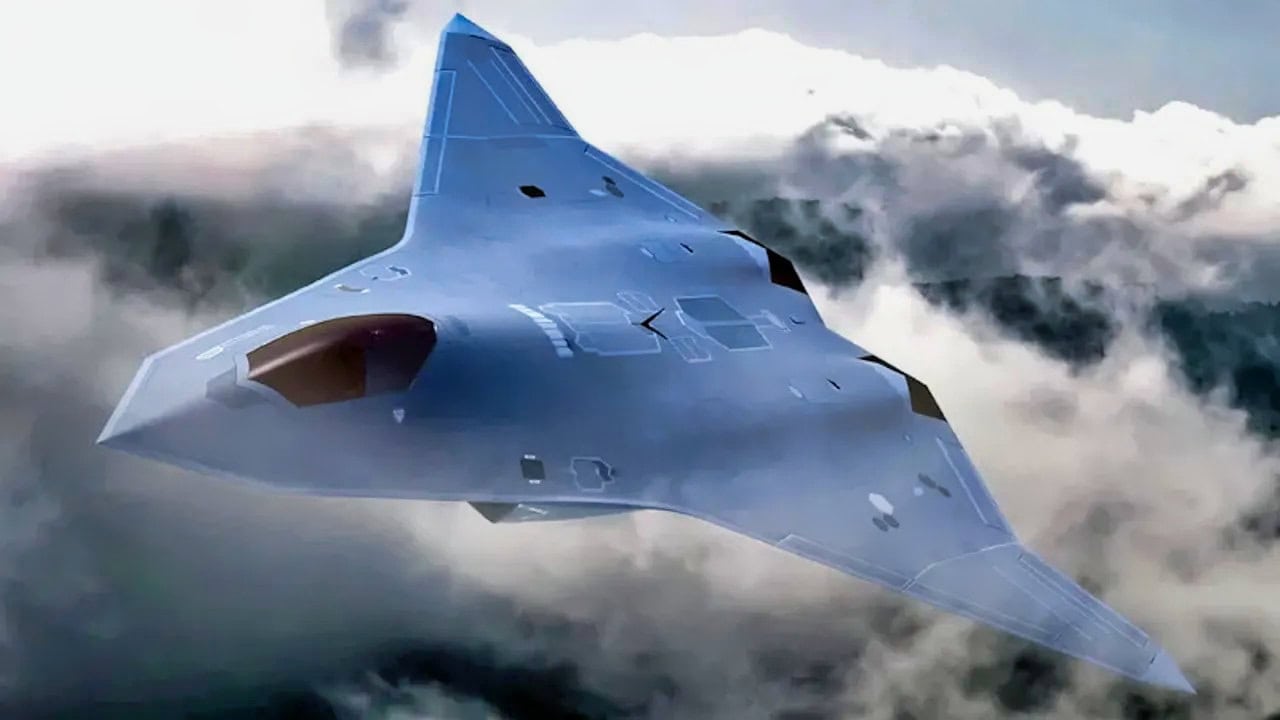Key Points and Summary – The Navy argues F/A-XX is essential alongside—not instead of—the F-35C.
-A sixth-gen strike fighter with ~25% more range (projected 1,700+ miles), deeper stealth, bigger internal payloads, and native control of collaborative combat aircraft, F/A-XX is built to fight through China’s DF-21D/DF-26B A2/AD bubble.

F/A-XX Handout Photo from Northrop Grumman.
-Paired with MQ-25 tankers, it pushes carrier airpower across ~11 million sq miles, extends survivability, and serves as a JADC2 node for manned-unmanned teams.
-Industry is also exploring a “Ferrari F-35” path to inject NGAD tech at lower cost, but advocates say only F/A-XX delivers the reach, command-and-control, and distributed lethality a Pacific fight demands.
Is The F/A-XX Necessary? The Navy Has The F-35
The United States Navy needs the F/A-XX, a sixth-generation fighter, because its current F-35C has range limitations, and F/A-18 Super Hornets have range and survivability limitations that the F/A-XX would overcome.
The F/A-XX is designed for significantly greater range, advanced stealth, and the ability to operate with autonomous drones, providing the carrier strike groups the power and reach needed to counter sophisticated threats like China’s advanced anti-ship systems.
This sixth-generation jet is crucial for retaining air superiority and ensuring the continued effectiveness of naval carrier air wings in high-end conflicts. The argument that the Navy already has the F-35 is countered by the fact that the F/A-XX is not meant to replace the F-35 but to enhance operations with the existing airframe in the Pacific.
The F/A-XX and MQ-25 Stingray expand the Navy’s operational area to 11 million square miles. This range signifies a significant leap in naval aviation, reinforcing strategic superiority. How does this all come together?
The F/A-XX Will Have Its Own Unique Role In the Navy
While the F-35C is a fifth-generation stealth fighter that is the most advanced aircraft in the world, the new F-47 and the F/A-XX will surpass the F-35.
The F/A-XX is planned to be a strike fighter with improved range, stealth, and the ability to carry larger internal payloads for deep strikes. The range is expected to be at least 25 percent more than the F-35C, potentially extending its reach to more than 1,700 miles.

Two F-35C Lightning II carrier variant joint strike fighters conduct the first catapult launches aboard the aircraft carrier USS Nimitz (CVN 68). The F-35 Lightning II Pax River Integrated Test Force from Air Test and Evaluation Squadron (VX) 23 is conducting initial at-sea trials aboard Nimitz. (U.S. Navy photo courtesy of Lockheed Martin by Dane Wiedmann/Released)

Billie Flynn, F-35 Pax River ITF, conducts an external GBU-31 and AIM-9x buffet and flutter test flight (Flt 592) from Naval Air Station Patuxent River, Maryland, April 4, 2018, in an F-35C test aircraft, CF-2. Photo courtesy of Lockheed Martin.
This range allows the Navy to project power over vast distances without requiring immediate refueling, a critical advantage in modern combat scenarios. Extended range enables strategic flexibility, ensuring the Navy can maintain air superiority across global theaters of interest.
China currently has the advantage of being able to target US aircraft carriers long before the carrier’s aviation assets can be brought to bear.
China’s A2/AD Defenses Present a Difficult Challenge
China has built a dense anti-access/area denial (A2/AD) envelope to protect its fleet and homeland from US strikes.
China’s strategy seems to be that, rather than engaging in combat with US carriers one-on-one, they will attempt to remove them from the equation entirely by engaging them from maximum distance.
China’s land-based DF-21D ‘carrier killer’ ballistic missile with 1000+ miles range—makes it possible to attack aircraft carriers over great distances at reduced or no risk. China has also developed the DF-26B missile that can reach US bases in Guam.
China is also advancing its own naval aviation. The introduction of the J-35 stealth carrier fighter and the KJ-600 airborne early warning aircraft strengthens China’s ability to contest sea and air control.
The increased range of the F/A-XX, combined with the “loyal wingman” drones, plans to counter those threats.
Collaborative Combat Aircraft (CCA) Integration
Energyreports.com wrote that the introduction of the F/A-XX, alongside the MQ-25 Stingray unmanned tanker, will expand the Navy’s carrier air wings’ area of effect to 11 million square miles.
This enormous operational scope is essential for maintaining a strategic advantage, enabling selective targeting and a prolonged presence in critical regions.
The ability to operate over such an expansive area enhances survivability for strike crews by increasing the uncertainty zone for adversaries. This capability aligns with the Navy’s strategic objectives, allowing effective navigation of complex intelligence, surveillance, and reconnaissance (ISR) environments.
A primary feature of the F/A-XX will be its role as a command and control platform for unmanned aerial drones. This CCA program will enhance the entire air wing’s combat effectiveness and range in contested environments.
The F/A-XX will incorporate key fifth and sixth-generation technologies—stealth radar cross-section minimization, networked sensors, and the capability to simultaneously control four drones, starting with new MQ-25 Stingrays entering service for mid-flight refueling (and likely other roles in time) and future carrier-based Loyal Wingmen drones armed with missiles or radars for combat tasks.
USNI reported earlier this month that the US Navy has contracted five defense firms—General Atomics, Boeing, Anduril, Northrop Grumman, and Lockheed Martin—to develop armed, unmanned aircraft and control systems for deployment across its 11 aircraft carriers.

F/A-XX Fighter Mockup. Image Credit: Creative Commons.
Secretary of Defense, or still unofficially the Secretary of War, Pete Hegseth, wrote a memo in July pressing Pentagon and combatant command officials to move out on the effort.
“I am rescinding restrictive policies that hindered production and limited access to these vital technologies, unleashing the combined potential of American manufacturing and warfighter ingenuity,” Hegseth wrote in the July 10 memo. “I am delegating authorities to procure and operate drones from the bureaucracy to our warfighters.”
In the event of a war with China, the F/A-XX could become even more critical than the F-47 due to the vast areas of the ocean that will need to be covered.
Issac Seitz, a leading private sector Intelligence Analyst, wrote a compelling article on why the F/A-XX is so sorely needed. He points out some intriguing facts about the F/A-XX.
“The F/A-XX is also designed to be a key node in the Pentagon’s Joint All-Domain Command and Control (JADC2) network.
“It will integrate with space-based assets, undersea platforms, and cyber-resilient systems, enabling multi-domain operations and distributed lethality.
“Its role as a command-and-control hub for unmanned systems and its compatibility with emerging technologies like adaptive propulsion and high-energy lasers position it as a central element of future carrier strike groups.”
The government is concerned about the simultaneous development of two new projects, citing budget constraints and production risks. However, one alternative Lockheed Martin has stated that they can make a “Ferrari F-35,” but incorporating some of its sixth-generation technology from the NGAD project.
Lockheed CEO Jim Taiclet said beefing up fifth-generation fighters like this would allow Lockheed to deliver “80% of the capability, potentially, at 50% of the cost per unit aircraft.”
“Eventually, there’ll be 3,500 of those [F-35] chassis out there at various stages of technology and capability [worldwide],” Taiclet said. “We think we can get most of the way to sixth-gen at half the cost.”
About the Author: Steve Balestrieri
Steve Balestrieri is a National Security Columnist. He served as a US Army Special Forces NCO and Warrant Officer. In addition to writing on defense, he covers the NFL for PatsFans.com and is a member of the Pro Football Writers of America (PFWA). His work was regularly featured in many military publications.
More Military
The New B-21 Raider Stealth Bomber Is Coming
The F-35 Fighter Has a ‘Secret’ That Is Right In Front of Your Eyes
Can the U.S. Navy Replace the Aircraft Carrier?










